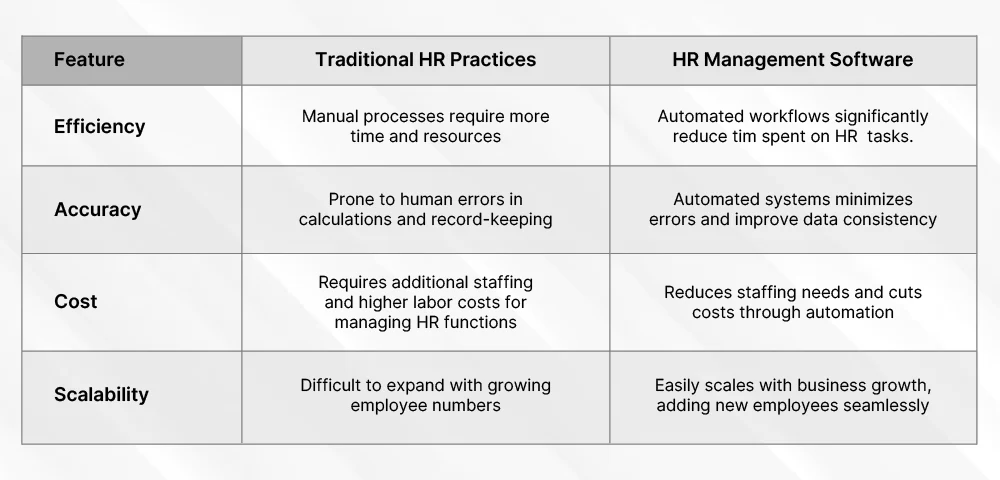Suppose your firm grows quickly, with many new workers and paperwork increasing unimaginably.
Imagine the relief of not having to spend hours on attendance, payroll discrepancies, and employee data management. This is the freedom that HR management software can bring, liberating you from the tedious tasks of traditional HR practices.
That's where HR management enters the picture — the key to successful companies. The actual game begins here: traditional HR practices slow down with the invention of the new tech HR management software to supercharge your daily HR operations.
Traditional HR Practices To Follow
Many years ago, many businesses performed HR operations manually. Yes. Using the pen and paper methodology to perform the following operations:
- Easily create and manage employee information
- Spreadsheets for performing payroll calculations
- Manual approvals for leave requests.
Sounds weird? Right?
This practice was challenging and time-consuming, too, as it led to inefficient procedures, delays, and mistakes that affected business performance.
What is HR Management Software?
HR management software is not just a tool - it's a source of empowerment. It combines employee information, cuts tedious work, and improves productivity, leaving you in command of your HR activities and making your business more efficient.
With cloud HR software such as HR HUB, you can access HR data everywhere, anytime. This convenience and flexibility make your HR processes more efficient, even in remote offices, providing you with peace of mind and authority.
Understanding Traditional HR Practices
Before the development of HR software, HR departments employed manual processes to conduct their operations. These included manually processing recruitment, employee files, payroll calculations, and performance monitoring.
Common Traditional HR Practices
- Paper-Based Record Keeping: A time-consuming process. Paper files are managed separately for employee contracts, appraisals, and records.
- Manual Payroll Management: The payroll computation was performed in spreadsheets or manually, subjecting it to human mistakes.
- Face-to-Face Interactions for Approvals: Employees run after their managers to seek leaves, obtain essential information, or solve HR-related problems.
- Limited Data Analytics: Extracting insights for employee performance, attendance, or salary projections involved laborious calculations, hindering strategic decision-making.
Pros of Traditional HR Practices
Let's highlight some prime advantages of having traditional HR practices in your business.
- Personalised Interactions: Direct interaction between employees and HR staff creates more intimacy and fosters trust.
- Low Training Needs: Manual HR processes are based on standard documents so that staff can handle basic HR functions without comprehensive software training.
- Process Control: Manual control of HR activities is favoured by some organisations over the use of automated processes, particularly for small firms with fewer staff.
- Budget-Friendly for Small Groups: For companies with limited HR requirements or new businesses, investing in software does not make economic sense; hence, using conventional methods is a workable solution for your business.
Cons of Traditional HR Practices
After discussing the advantages, it is important to note some major disadvantages of having traditional HR practices within your company.
- Time-Consuming Processes: Data entry, filing documents, and employee records are time-consuming and inefficient.
- Error-Prone: Manual payroll calculation or leave administration can result in perpetual errors, which may result in overpayment, compliance issues, or irate employees.
- Poor Data Security: Physical documents can be destroyed, lost, or accessed by unauthorized individuals, considerably endangering employee data.
- Limited Scalability: As the company expands, handling more people manually is hard, raising the possibility of inefficiency and errors.
- Lack of Real-Time Insights: HR managers lack immediate insights into workforce trends, staff engagement, or performance without using automated reporting software.
Companies that only stick to conventional practices might not be able to meet industry requirements and employee demands.
The Rise of HR Management Software
Think about converting your messy HR desk into a clean digital dashboard. That's what HR management system software can do.
HR software is made to mechanize routine processes like payroll computations, employee attendance management, and leave approvals. With all the HR data combined into a single platform, businesses can reduce errors, automate processes, and empower employees through self-service functionality.
Types of HR Software
Now, let’s dive deep into understanding the different types of HR software.
- Recruitment Platforms: Streamline job posting, resume filtering, and interview scheduling to ease recruitment.
- Payroll Management Systems: Perform accurate salary computation, tax withholding, and compliance with labor laws.
- Performance Management Tools: Monitor staff development, establish objectives, and encourage regular feedback sessions to manage employee performance.
- Employee Self-Service Portals: Employees can easily see payslips, apply leave requests, and modify personal information independently.
- Time & Attendance Tracking Systems: With software, shift planning, attendance tracking, and overtime computation are easy to deal with in workforce management.
- Training & Development Platforms: Offer tailored training programs to enhance employee development and skills.
By combining these tools, organizations can save hours of manual effort while increasing data accuracy.
Comparing HR Management Software and Traditional HR Practices
Time to put these two head-to-head! - HR software vs. traditional HR.

What are The Benefits of Having HR Management Software for Businesses?
New HR software is not automation; it is getting your employees involved and empowering HR staff with the right tools to succeed.
Main benefits of HR software:
- Speedier Recruitment: Automates interview scheduling, candidate follow-up, and resume screening to accelerate recruitment.
- Simple Payroll Management: Accurately computes salary taxes and complies with local laws, avoiding costly payroll mistakes.
- Higher Employee Engagement: Self-service portals allow employees to access payslips, request leaves, and update details without the support of HR.
- Improved Performance Management: Technology offers insights into data, goal monitoring, and feedback processes to support staff improvement.
- Data-Driven Insights: HR divisions can discover patterns in the employee base, monitor employee satisfaction levels, and predict future staff requirements with combined analytics.
- Greater Compliance: HR procedures align with changing labour law through automatic updates, eliminating compliance risk.
Companies using HR software gain increased productivity, enhanced data insight, and happier employees by adopting such advantages of HR management systems. In conclusion, the benefits of HR management software far outweigh the limitations of traditional HR practices, making it a compelling choice for businesses looking to improve their HR operations.
A Step-by-Step Guide to HR Management Software Implementation
Migrating from manual procedures to HR software? Here's your guide:
Step 1: Define HR Policies & Modules
- Identify the key HR modules you want to implement (e.g., payroll, attendance, recruitment, performance management).
- Establish clear HR policies aligned with company goals and regulatory compliance.
- Determine employee access levels and approval workflows for each module.
Step 2: Provide Policy Details & Rule Configuration
- Document all policy rules, such as leave policies, payroll calculations, tax compliance, and performance evaluation criteria.
- Ensure the software supports custom policy configurations that match your business structure.
- Validate compliance with local labor laws and internal company guidelines.
Step 3: Plan & Execute Data Migration
- Develop a data migration strategy to securely migrate employee records, attendance records, payroll information, and HR papers.
- De-duplicate or cleanse data before migration to prevent duplication or errors.
- Perform pilot migrations to confirm data integrity before roll-out.
Step 4: System Configuration & Live Planning
- Configure software settings as per your workflows and HR policies.
- Validate functionalities like payroll calculations, leave approvals, and reporting dashboards.
- Utilize a phased or complete go-live strategy to minimise business disruption.
Step 5: Employee Training & System Adoption
- Organize the training sessions for HR personnel, managers, and employees to familiarize them with the new system.
- Release thorough user guides and self-service materials to enable them to transition easily.
- Create a helpdesk or support team to deal with the early questions posed by the employees.
Step 6: Continuing Support & Optimization
- Regularly monitor system performance and solicit user feedback.
- Determine areas of improvement and simplify processes accordingly.
- Provide frequent updates and patches for security to ensure system effectiveness.
Following these phases, companies can effectively migrate to HR management software, increasing efficiency, compliance, and staff involvement.

Selecting the Perfect HR Management Software
Looking for the best HR software that suits your business always appears to be wandering through a labyrinth. Do not worry; we are here to give you the best possible answer to simplify things.
Consider the main points you must look for before choosing the ideal HR management software solution for your business requirements.
- Easy-to-Use Interface: Your selected HR management software solution must be simple for employees, HR, and admin personnel.
- Customization Options: Choose software that can customize features according to your organization's requirements.
- Integration: Ensure the platform integrates well with payroll, attendance, and other major systems.
- Scalability: Choose a solution that scales according to business requirements.
- Security Features: Preference software with high encryption and access controls to protect sensitive employee data.
- Customer Support: Verify that the provider offers good technical and troubleshooting support.

Costing Aspects of HR Management Software vs. Traditional HR Practices
Conventional HR processes are manpower-intensive, requiring adequate time and paper wastage. It looks inexpensive initially, but they are more resource-intensive.
On the other hand, the HR software is expensive but provides impressive and smooth HR operations for your daily business needs.
The primary roles of the HR management software solution are to not only save resources but also to show the outcomes by:
- Optimizing efficiency
- Minimizing the errors, and
- Lowering administrative weights
So, inversing the correct software investment will result in substantial cost savings over the long run.
Case Studies & Success Stories
SignO Solutions - A mid-sized organization with multiple challenges in manual payroll operations. They faced multiple complexities in performing payroll operations for multiple employees at once.
Once they switched to HR HUB, the scenario changed totally -
- Reduced payroll processing time by 40%
- Enhanced worker satisfaction by resolving queries more quickly
- Improved data protection through cloud-based bookkeeping
HR HUB: Embrace the Future of HR Operations
Gone are the days of drowning in paper. Traditional HR practices might be comfortable. However, the bitter truth is that it cannot compete with modern HR software's accuracy, efficiency, and scalability.
HR HUB is here to assist you in unleashing the full potential of your HR processes.
Do you know why? It has many powerful features like payroll, attendance, performance management, etc.
Join the future of HR with HR HUB and transform your business today.




